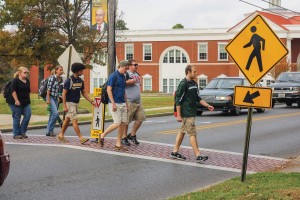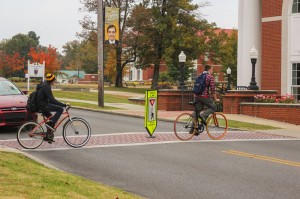Weeks after installing street signs along the crosswalks on 16th Street, the University has hired the engineering and testing firm of Bacon Farmer Workman Engineering & Testing, Inc. to research a more permanent solution to a problem that has plagued Murray State since its western expansion.
The street signs were put in place this month in order to aid students in crossing the street as well as cars that use the road. According to the study recently completed by Bacon Farmer Workman Engineering & Testing, Inc., more than 11,000 vehicles use this strip of road a day, and there are approximately 6,000 crossings made by pedestrians.
The study showcases three possible options for the street, other than doing nothing, and analyzed these plans based on the impact on existing and planned development, the impact on mobility, the environment and safety, as well as how easy they would be to implement. The study rated each plan in these five categories as “good,” “fair,” or “poor.”

Students cross 16th Street on one of the crosswalks with a safety sign in the middle of it. This sign was replaced after being hit by several vehicles.
The first alternative to the street signs is to close 16th Street from Miller Street to Calloway Avenue to thru traffic, re-routing traffic to Murray’s remaining street system. According to the study, closing this section of 16th Street would add approximately 5,800 more vehicles to 12th Street’s traffic between Main and Chestnut as well as approximately 3,500 more vehicles to sections of 18th Street, Main Street and other parts of 16th Street.
This plan was rated “poor” in the categories of its impact on existing and planned development and mobility, “good” in the categories of its impact on the environment and safety and “fair” for its ease of implementation.
The second alternative would be to reconstruct 16th Street with a depressed-elevated roadway from Miller Street to Calloway Avenue. At the cost of $9.3 million, the section of 16th Street from Miller Street to Alexander Hall would be depressed and a raised roadway would be constructed from Alexander Hall to Calloway Avenue.
Over this depressed section, two pedestrian overpasses would be constructed allowing students to walk above the traffic while where 16th Street would be elevated, a pedestrian underpass would be created allowing traffic to pass over pedestrians.
This plan was rated “good” in the categories of its impact on existing and planned development, mobility and safety and “fair” for its impact on the environment and ease of implementation.

Students on bicycles cross 16th street near one of the original signs.
The final recommendation made by Bacon Farmer Workman Engineering & Testing, Inc. was to relocate the section of North 16th Street from Miller Street to Calloway Avenue to the west by one block creating a mini-bypass of west campus. The proposed relocation would follow what is currently Olive Street, Kentucky Avenue and Calloway Avenue, include two 12 feet lanes, bike lanes and sidewalks on each side of the new street.
The cost of construction of this would be $8.3 million as well as $300,000 for the cost of the relocation.
This plan was rated “fair” in all categories.
Tim Miller, interim president, said 16th Street is a priority for him and the University because of the amount of traffic that stretch of road sees and how many students utilize that crossing.
He said meetings have been scheduled with the state transportation department in which the University will be asking for the funds necessary to finance these plans and that hopefully the state will be receptive to their request.
Said Miller: “(16th Street) is a problem. We have got to do something.”
Story by Ben Manhanke, Assistant News Editor